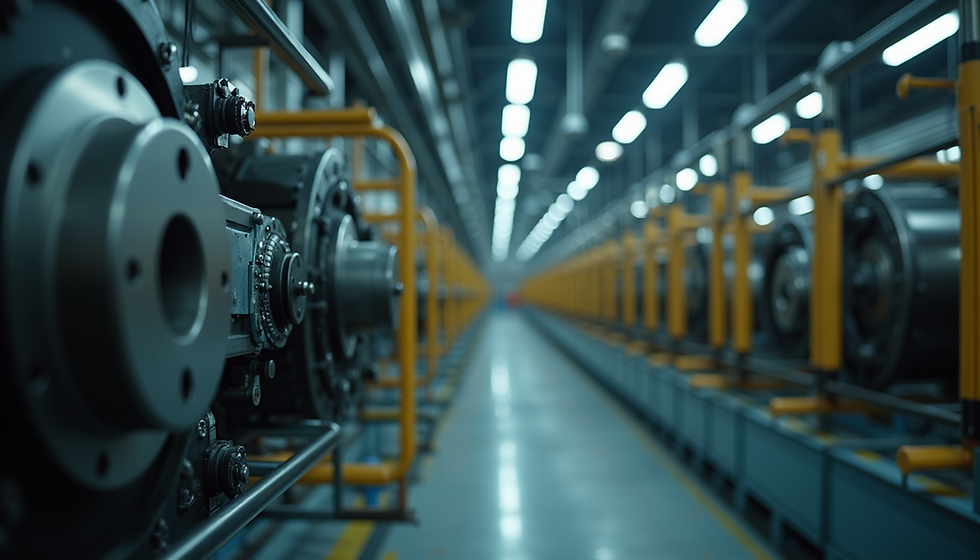Enhancing Mining Safety with Advanced AI Solutions
- ekin eraydin
- Aug 11
- 4 min read
Mining is a critical industry that powers many aspects of modern life. However, it is also one of the most hazardous sectors, with risks ranging from equipment accidents to environmental hazards. Recent advancements in artificial intelligence (AI) are transforming how mining companies approach safety. By integrating AI technologies, mines can significantly reduce accidents, improve emergency responses, and protect workers more effectively.
The Role of AI for Mine Safety
Artificial intelligence is revolutionising mine safety by providing real-time monitoring, predictive analytics, and automated responses. AI systems can process vast amounts of data from sensors, cameras, and other devices to detect potential dangers before they escalate. For example, AI algorithms can identify structural weaknesses in tunnels or detect hazardous gas levels, alerting workers and management immediately.
One practical application is the use of AI-powered drones for underground inspections. These drones can navigate confined spaces, capturing high-resolution images and videos that AI software analyses to spot cracks, water leaks, or other safety concerns. This reduces the need for human inspectors to enter dangerous areas, lowering the risk of injury.
Another key benefit of AI is predictive maintenance. Mining equipment is subject to heavy wear and tear, and unexpected breakdowns can cause accidents. AI models analyse equipment data to predict failures before they happen, allowing timely repairs and preventing hazardous situations.
Key benefits of AI for mine safety include:
Continuous real-time monitoring of mine conditions
Early detection of hazards such as gas leaks or structural faults
Automated alerts and emergency response coordination
Predictive maintenance to avoid equipment failures
Enhanced worker safety through remote inspections

Implementing AI Technologies in Mining Operations
Integrating AI into mining safety requires a strategic approach. Companies must first assess their current safety challenges and identify where AI can add the most value. This often involves installing IoT (Internet of Things) sensors throughout the mine to collect environmental and equipment data.
Once data collection is established, AI software platforms analyse the information to provide actionable insights. For example, AI can track air quality, temperature, and humidity levels, ensuring they remain within safe limits. If any parameter exceeds thresholds, the system triggers alarms and initiates evacuation protocols if necessary.
Training staff to work alongside AI systems is also crucial. Workers need to understand how to interpret AI alerts and respond appropriately. Regular drills incorporating AI alerts can improve readiness and reduce panic during real emergencies.
Mining companies can also leverage AI-powered video analytics to monitor worker behaviour and ensure compliance with safety protocols. Cameras equipped with AI can detect if workers are wearing protective gear or if they enter restricted zones, sending instant notifications to supervisors.
Steps to implement AI for mine safety:
Conduct a safety audit to identify risks
Deploy IoT sensors and data collection devices
Integrate AI analytics platforms for real-time monitoring
Train employees on AI system usage and emergency procedures
Continuously evaluate and update AI models based on new data

How AI Enhances Emergency Response in Mines
Emergencies in mining, such as collapses or gas leaks, require swift and coordinated responses. AI enhances emergency management by providing accurate situational awareness and automating communication channels.
For instance, AI systems can instantly analyse sensor data to pinpoint the location of an incident. This information helps rescue teams navigate safely and efficiently. AI can also predict the spread of hazardous gases or fires, allowing responders to plan evacuation routes and containment strategies.
Communication platforms powered by AI can send automated alerts to all personnel, ensuring everyone receives timely warnings. These systems can also prioritise messages based on severity and affected areas, reducing confusion during crises.
Moreover, AI-driven simulations can prepare teams for various emergency scenarios. By running virtual drills, mining companies can identify weaknesses in their response plans and improve coordination among different teams.
AI-driven emergency response advantages:
Faster detection and localisation of incidents
Automated, targeted communication to workers and responders
Predictive modelling of hazard spread and impact
Enhanced training through realistic simulations

Practical Recommendations for Mining Companies
To maximise the benefits of AI in mining safety, companies should follow these practical recommendations:
Start small and scale up: Begin with pilot projects focusing on high-risk areas before expanding AI deployment across the entire operation.
Collaborate with AI experts: Partner with technology providers who specialise in mining safety solutions to ensure customised and effective implementations.
Maintain data quality: Ensure sensors and devices are regularly calibrated and maintained to provide accurate data for AI analysis.
Integrate AI with existing safety protocols: AI should complement, not replace, traditional safety measures and human oversight.
Invest in continuous training: Keep workers updated on new AI tools and safety procedures through ongoing education programs.
One example of a cutting-edge solution is mine guard ai, which offers AI-powered monitoring and predictive analytics tailored for mining environments. Solutions like this demonstrate how AI can be seamlessly integrated to enhance safety without disrupting operations.
The Future of AI in Mining Safety
The future of mining safety lies in increasingly sophisticated AI technologies. Advances in machine learning, computer vision, and robotics will enable even more precise hazard detection and autonomous safety interventions.
We can expect AI to play a larger role in automating routine safety inspections, reducing human exposure to dangerous conditions. Wearable AI devices may monitor individual workers’ health and environmental exposure in real time, providing personalised safety alerts.
Furthermore, AI-driven data analytics will help mining companies identify long-term safety trends and develop proactive strategies. This shift from reactive to predictive safety management will save lives and reduce operational costs.
As AI continues to evolve, collaboration between technology developers, mining companies, and regulators will be essential to establish standards and best practices that ensure safe and responsible AI use.
By embracing advanced AI solutions, the mining industry can create safer workplaces and protect its most valuable asset - its people. The integration of AI technologies is not just a technological upgrade but a vital step towards a sustainable and secure mining future.

Comments